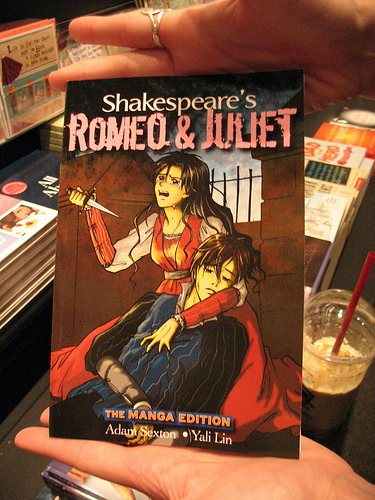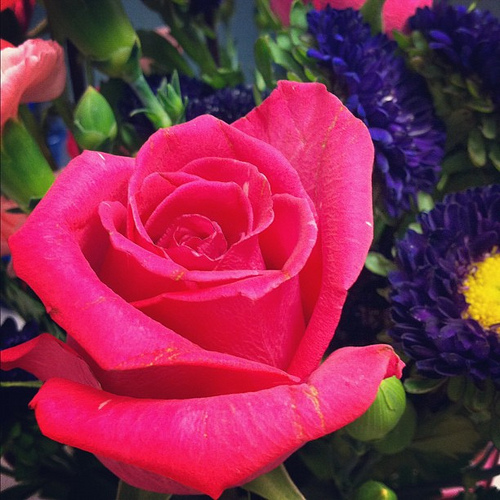
Source: Procession of Characters from Shakespeare’s Plays - Google Art Project, Wikimedia
Motifs are repeating elements that point to a play’s theme. A motif can be an idea, an object, an image, or even a word or phrase. Some motifs are archetypes because they have appeared in literature across time periods and cultures. Just like symbols, archetypes can be words, images, colors, or sounds that represent something else. Let’s look below at some common motifs found in plays.
Disguises
The use of disguises by characters is a reigning motif in many plays, particularly Shakespeare’s comedies (but some of his tragedies, too.) In Greek literature, the gods would assume disguises to communicate with humans. Villains wear disguises to get close to their prey; for example, the Big Bad Wolf disguises himself as Grandma to get close to Little Red Riding Hood.

Source: Mask, poropitia outside the box, Flickr
Because plays are performed, the use of a disguise motif draws the audience into the action: They know something the characters on stage do not. In Shakespeare’s Twelfth Night, disguise creates angst for several romantic couples. Viola disguises herself as a man, Cesario, and is sent by Duke Orsino to profess the Duke’s love for Olivia. Believing Cesario (Viola) is really a man, Olivia falls in love with Cesario. Meanwhile, Viola falls in love with the Duke, who believes that she is a man, and he falls in love with Olivia.
In the excerpt below, the Duke sends Cesario (Viola) to tell Olivia of his love. Olivia has sworn off love for seven years to mourn her brother’s death, but the Duke hopes to speed up her timetable.
Cesario (Viola) asks the Duke what he will do if Olivia says she cannot love him. The Duke says he can’t be denied; his love is too strong. Cesario says his sister once pined in secret for a man. The audience understands that Viola is speaking of herself, but the Duke remains clueless. These disguises help to illustrate a theme in the play: Love causes suffering.
 Now, read the excerpt from Twelfth Night, act 2, scene 4, to get a feel for how Shakespeare creates motifs. When you have finished reading, use your notes to answer the questions that follow.
Now, read the excerpt from Twelfth Night, act 2, scene 4, to get a feel for how Shakespeare creates motifs. When you have finished reading, use your notes to answer the questions that follow. DUKE ORSINO
Let all the rest give place.
(CURIO and Attendants retire)
Once more, Cesario,
Get thee to yond same sovereign cruelty:
Tell her, my love, more noble than the world,
Prizes not quantity of dirty lands;
The parts that fortune hath bestow’d upon her,
Tell her, I hold as giddily as fortune;
But ’tis that miracle and queen of gems
That nature pranks her in, attracts my soul.
VIOLA [Disguised as CESARIO]
But if she cannot love you, sir?
DUKE ORSINO
I cannot be so answer’d.
VIOLA
Sooth, but you must.
Say that some lady, as perhaps there is,
Hath for your love a great a pang of heart
As you have for Olivia: you cannot love her;
You tell her so; must she not then be answer’d?
DUKE ORSINO
There is no woman’s sides
Can bide the beating of so strong a passion
As love doth give my heart; no woman’s heart
So big, to hold so much; they lack retention
Alas, their love may be call’d appetite,
No motion of the liver, but the palate,
That suffer surfeit, cloyment and revolt;
But mine is all as hungry as the sea,
And can digest as much: make no compare
Between that love a woman can bear me
And that I owe Olivia.
VIOLA
Ay, but I know—
DUKE ORSINO
What dost thou know?
VIOLA
Too well what love women to men may owe:
In faith, they are as true of heart as we.
My father had a daughter loved a man,
As it might be, perhaps, were I a woman,
I should your lordship.
DUKE ORSINO
And what’s her history?
VIOLA
A blank, my lord. She never told her love,
But let concealment, like a worm i’ the bud,
Feed on her damask cheek: she pined in thought,
And with a green and yellow melancholy
She sat like patience on a monument,
Smiling at grief. Was not this love indeed?
We men may say more, swear more: but indeed
Our shows are more than will; for still we prove
Much in our vows, but little in our love.
DUKE ORSINO
But died thy sister of her love, my boy?
VIOLA
I am all the daughters of my father’s house,
And all the brothers too: and yet I know not.
Sir, shall I to this lady?
DUKE ORSINO
Ay, that’s the theme.
To her in haste; give her this jewel; say,
My love can give no place, bide no denay.

1. Why might Viola disguised as Cesario ask the Duke what will happen if Olivia denies him? Using evidence from the text, support your answer.
Sample Response:
Viola is in love with the Duke, so it’s in her interest to know what he will do if Olivia won’t have him. She says in her second speech that there might be a lady (Viola) who loves the Duke as much as he loves Olivia.
2. Explain the irony in Viola’s fourth speech.
Sample Response:
Viola says she knows “too well” what love women to men may owe. The irony is that she really does know because, of course, she’s a woman. The Duke thinks he’s talking to a man who is just offering an opinion.
3. Why is Viola’s fifth speech an example of dramatic irony?
Sample Response:
The audience knows that Viola is disguised as a man. When she speaks of concealing her love, the audience knows that there is perhaps a double meaning. She is literally concealing her love behind the disguise, and she may have concealed it or hidden it from other people and the Duke.
4. What does Viola mean in her last speech when she says, “I am all the daughters of my father’s house, and all the brothers too”?
Sample Response:
Viola is disguised as a man so she is the “brothers,” but she’s really the “daughters” of her father’s house.
Light and dark

Source: Romeo and Juliet: Manga
Edition, jmawork, Flickr
Another visual motif that appears frequently in plays is the use of light and dark imagery on stage. Sometimes light and dark is metaphoric, so that light symbolizes good, and dark symbolizes bad or evil.
Sometimes light is used to emphasize contrasts or opposites. In Shakespeare’s Romeo and Juliet, light and dark imagery emphasizes contrasts. For example, Romeo compares Juliet to the sun. (Rosaline, Romeo’s former love interest, was his “moon” before he met Juliet.) Because Romeo and Juliet are forced to meet under the cover of night, night becomes day, and day becomes night.
Color

Source: Blue dream, marc home, Flickr

Source: Flatness and fertility,
florriebassingbourne, Flickr

Source: Valentine's Flowers!,
dianaschnuth, Flickr
Colors have meaning, and the recurrence of a specific color in a play is significant. On the right are several colors and their symbolic meanings. You are likely familiar with the colors in the fairy tale of “Snow White.” Snow White (purity) is given a poisoned red (danger) apple by the evil queen who, in the Disney movie, is dressed in black (evil).
Red: passion, violence, danger
Blue: calmness and serenity
Black: darkness, evil, chaos
White: purity
Green: growth and fertility